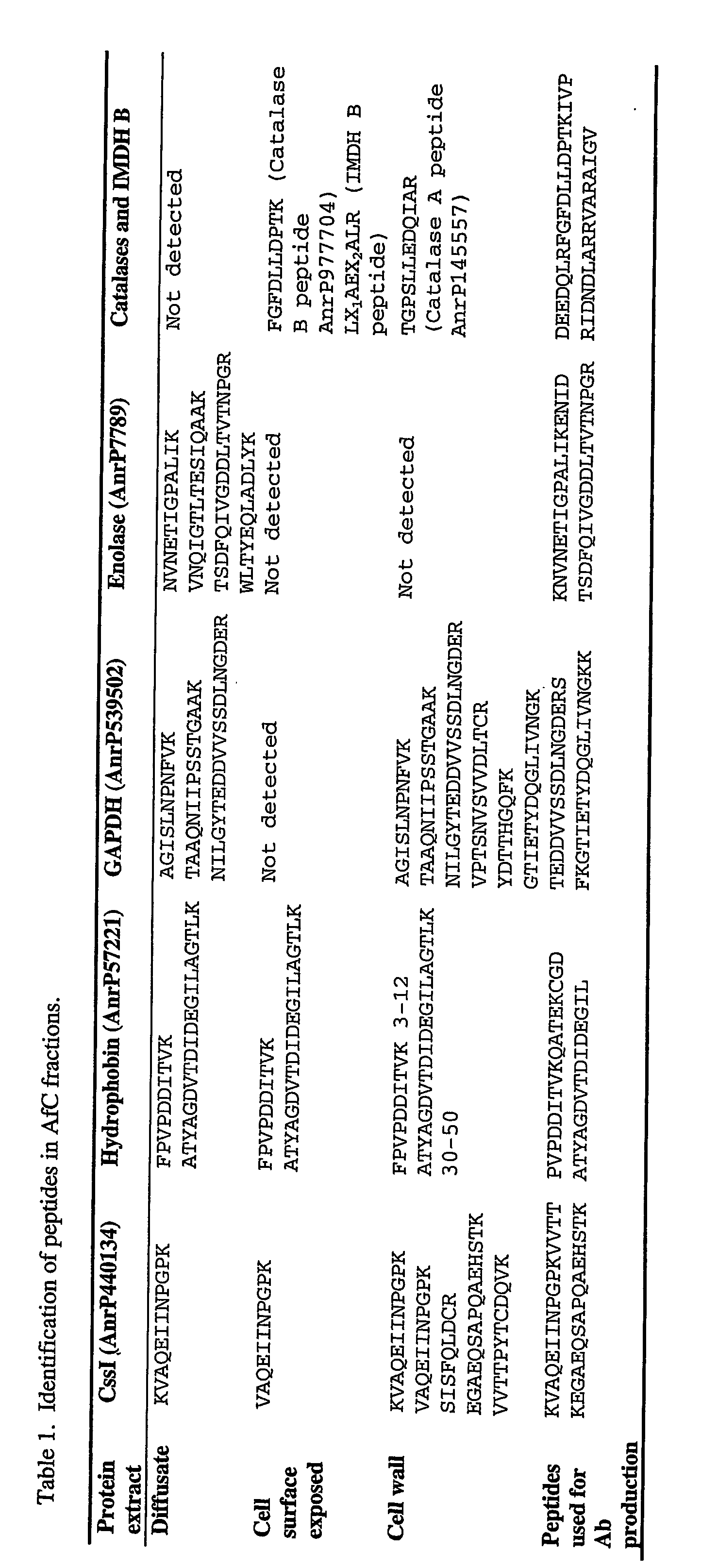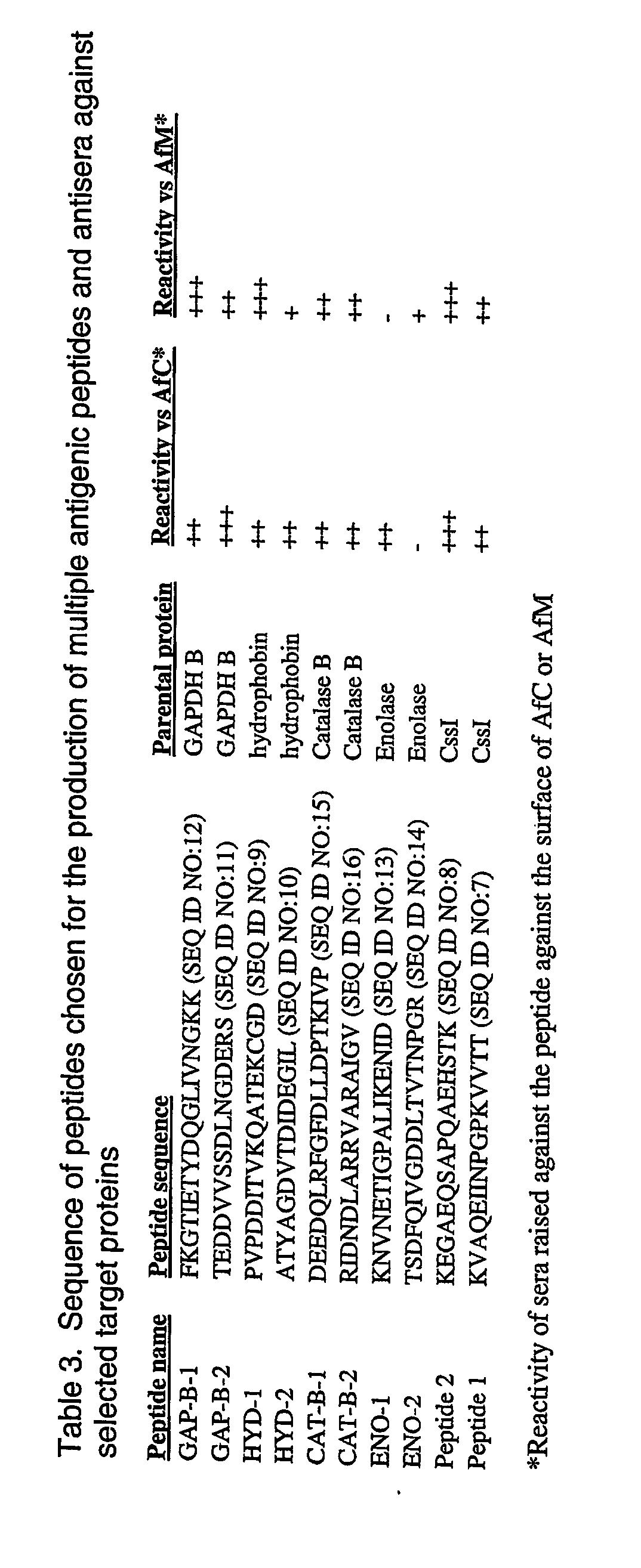Extracellular aspergillus polypeptides
a technology of aspergillus and polypeptides, applied in the field of extracellular polypeptides, can solve the problems of difficult to predict which polypeptides can be found extracellularly, high uncertainty in prediction,
- Summary
- Abstract
- Description
- Claims
- Application Information
AI Technical Summary
Benefits of technology
Problems solved by technology
Method used
Image
Examples
example 1
Identification of Peptides in Extracts of A. fumigatus
[0277] A number of protein purification procedures were used to facilitate identification of A. fumigatus proteins that are secreted, cell-surface exposed or cell-wall associated. Proteins were then identified from these extracts via mass spectrometry techniques.
[0278] Culture of A. fumigatus. A. fumigatus conidia (AfC) of strain NCPF 2140 or ATCC 46640 were routinely prepared by inoculation of malt agar plates with AfC and subsequent growth at 30° C. for 10 days.
[0279] Preparation of a diffusible extract from A. fumigatus conidia. A. fumigatus Diffusate (AfD) was routinely prepared as follows. AfC (2×108) were added to water (0.5 ml) containing protease inhibitors (Roche, cat. no. 1 697 498) and the mixture was vortexed and then sonicated to solubilise the AfC. The resultant solution was incubated for 1 hour at 37° C., with shaking. AfD was then separated from washed spores by passage through a 0.2 μm filter, or, by centrifug...
example 2
Bioinformatic Analyses
[0289] SignalP predictions were performed using the parameters recommended for a eukaryotic protein, while Antigenicity index studies were performed using the default parameters determined by DNAStar. BLAST searches were performed using default parameters.
Analysis of CssI for the presence of a signal peptide.
[0290] The group who reported the original hypothetical sequence predicted an N-terminal signal peptide of 24 residues (NCBI entry CAD29600. Protein AfA35G10.07). However, a repeat of these studies using the SignalP program with default parameters (Nielsen et al. (1997) Protein Engineering 10, 1-6) indicates the presence of a 47-residue signal peptide with predicted signal cleavage occurring between A47 and R48.
Analysis of the predicted protein sequence of CssI.
[0291] A brief overview of the sequence of this protein reveals the two most abundant residues to be E and Q, which comprise 9.62% and 8.64%, respectively, of all residues in the protein. A cl...
example 3
Generation and Properties of Anti-AfM and Anti-IMDH Antibodies
Methods
[0299] PBS tablets (Sigma) were used to produce a final solution of 0.01M phosphate buffer, 0.0027 M KCl and 0.137 NaCl, pH 7.4 at 25° C.
Generation of Anti-Aspergillus fumigatus mycelia (anti-AfM) Antibodies
[0300] AfM-rich preparations were grown as follows: 10E5 AfC were added to 10 ml RPMI and incubated for approximately 10 hours at 37° C. AfM were then harvested by centrifugation and washed twice in PBS. These preparations were fixed by incubation in 3% formaldehyde for 30 min at room temperature, washed and 100 μg quantities injected into rabbits according to the following protocol.
[0301] Null sera was collected from New Zealand White female rabbits (4-6 months old, approximately 3 kg) prior to immunisation with 100 μg AfM and Freunds complete adjuvant. A booster was administered on day 14 in conjunction with Freunds incomplete adjuvant and again on day 28. The first and second...
PUM
| Property | Measurement | Unit |
|---|---|---|
| Fraction | aaaaa | aaaaa |
| Fraction | aaaaa | aaaaa |
| Fraction | aaaaa | aaaaa |
Abstract
Description
Claims
Application Information
 Login to View More
Login to View More - R&D
- Intellectual Property
- Life Sciences
- Materials
- Tech Scout
- Unparalleled Data Quality
- Higher Quality Content
- 60% Fewer Hallucinations
Browse by: Latest US Patents, China's latest patents, Technical Efficacy Thesaurus, Application Domain, Technology Topic, Popular Technical Reports.
© 2025 PatSnap. All rights reserved.Legal|Privacy policy|Modern Slavery Act Transparency Statement|Sitemap|About US| Contact US: help@patsnap.com



